Live outside the earth
Hello! This is Alexander Shaenko, I managed the project “Mayak” . My colleagues and I built and launched the first in the history of Russia satellite created by the crowdfunding method. As it suddenly turned out, he had a successor or something like that :) I'm talking about the Humanity Star , launched into orbit in the first successful launch of the Electron launch vehicle from Rocket Labs on January 21, 2018.
But today it is not about them. I would like to tell you about the project on creating a biological life support system, which we started after Mayak, and why it was for her.
I already wrote that the idea of the Beacon satellite was to show that now in Russia the most ordinary people, like reading this% Username%% article, can create and launch their own spacecraft into space. With the space program you can do it personally, with your own hands, without working in large KBs, not being a millionaire, now in Russia. That you can not only subscribe to the instagram of NASA or Roscosmos or watch popular science lectures, but make your own space projects.
Even while working on Mayak, we thought about what our next project would be and decided that it should contribute to the space program and help it to go beyond the limits of the earth orbit.
')
Well, we want to contribute, but what and where? And here there are many options.
Personally, in my opinion, the last big thing in the manned space program was made in 1969, when the first Apollo expedition set out on the moon. After it, there were five more successful flights, but after them, as early as 1972, not a single person rose above 1000 km above the Earth. None, although it's been 45 years! All cosmonautics, I recall, has only 60 years! And most of this time, people tread on a patch around the Earth!
It seems to me that this is not very cool, and something needs to be done about it. The experience of “Selenohod” and especially “Luna-Glob” aka “Luna-25” taught that it is better to work on your own.
And what do you actually need in order to fly beyond the limits of low-Earth orbit?
If we talk completely about the distant perspective, not just about flights to the Moon or Mars, for which approximately the existing technological level is enough, we need:
Most of this list looks very heavy for a team of 10 people working in their free time. Most of the list, but not all :)
I considered that biological life support systems (LSS) are the direction that can be started to develop without super-laboratories and multi-billion investments. They need plants, greenhouses, something simpler than accelerators for studying antimatter :) In addition, I heard that in Russia they were engaged in this issue and achieved some success, in particular, they built both purely technical systems and systems based on chlorella microalgae and higher plants . I talked about BSZHO with Oleg Voloshin, the press secretary of the Institute of Biomedical Problems (IBMP) of the Russian Academy of Sciences, and he introduced me to Margarita Alexandrovna Levinskikh, who is working in this area.
Before telling about the work in the field of FFSW, it is necessary to explain why life support systems are needed at all and how they developed.
It should be noted that the history of life support systems development is magnificently described in the actor speech “Life support systems of habitable space objects (Past, Present and Future)” by Dr. Yu.E., Doctor of Technical Sciences, Professor, Honored Scientist of the Russian Federation. Bruise
First we need to give a formal definition of a life support system. To do this, we have GOST 28040-89 "Life support system for an astronaut in a manned spacecraft." According to him, the LSS of the cosmonaut is a combination of functionally interrelated means and activities designed to create conditions in the habitable compartment of a manned spacecraft that maintain the energy exchange of the cosmonaut's body with the environment at the level necessary to maintain its health and efficiency.

Usually it includes:
SOGS - gas supply system,
NWO - water supply system,
SSGO - system of sanitary and hygienic maintenance,
SOP - power supply system,
SOTR - system for ensuring thermal conditions.
Now you can talk about how life support systems have evolved.
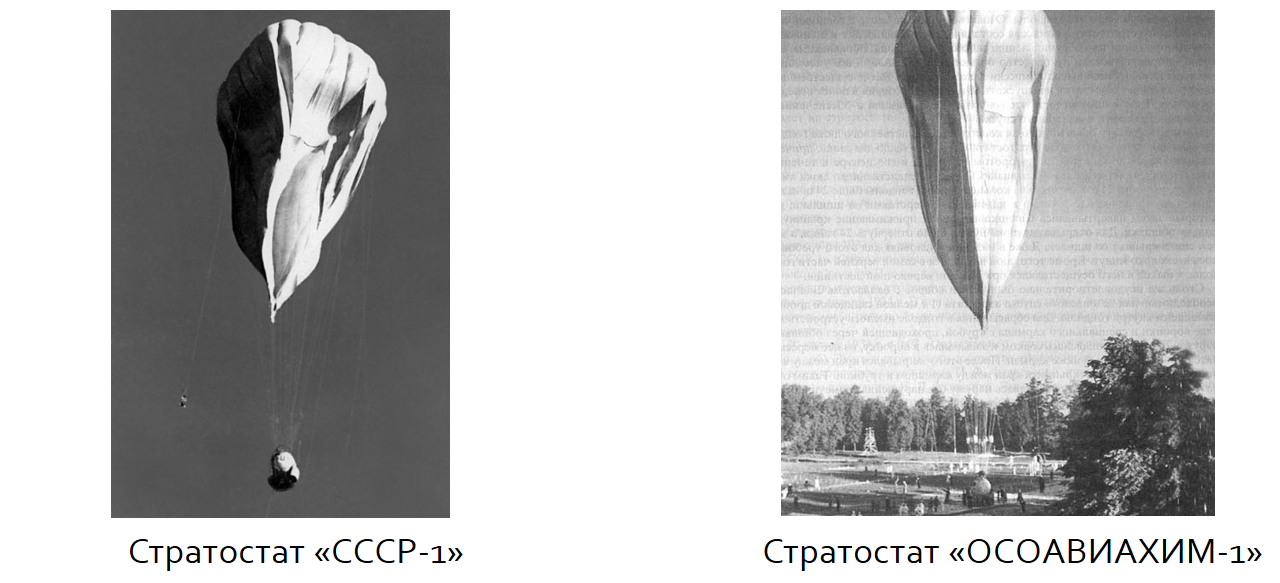
The first LSS appeared before human space flight and were intended to provide crews with work on stratostatos, high-altitude aircraft, as well as to ensure the vital activity of animals, mainly dogs.
Maintaining the normal composition of the atmosphere was ensured by introducing into its composition oxygen from gaseous or liquefied reserves and the removal of carbon dioxide using chemical reactions of the form:
The systems for space were created on the basis of the LSS.
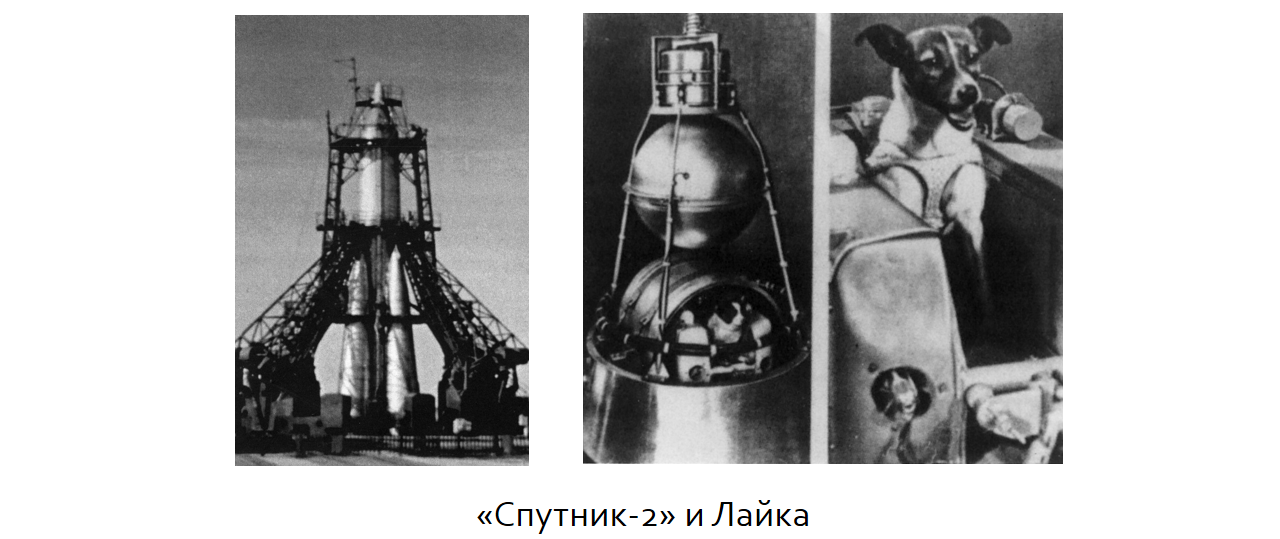
The first space communications system was first used to support the flight of a Laika dog on the Sputnik-2 spacecraft.
Maintaining the normal composition of the atmosphere was provided by the organization of chemical reactions according to the following scheme:
In addition, prototyping devices and a cesspool device were tested in this flight.
On spaceships like Vostok, Voskhod and Soyuz, a chemical reaction scheme was used, similar to that on Sputnik 2, but activated carbon was additionally used for air purification, and on Soyuz ships lithium hydroxide. In addition, on board were cylinders with oxygen and air. The atmosphere was controlled by the content of oxygen and carbon dioxide. The water, preserved by the preparation of silver, was stored on board in metal vessels with an internal volume covered with two-layer polyethylene. In addition, there was a cesspool device and a thermal control system on board.

The reason for the appearance of partially closed LSS is the need to deliver a large amount of oxygen, water, food from the Earth during long space flights with the first LSS. An illustration to the increase in the duration of flights is a table with some typical examples, below is a mass summary of the spent- life components of the life-support system during a flight to Mars with a duration of 500 days according to the performance speech of Yu.E. Bruise


Here it must be said that the estimates for the mass of water for a flight to Mars are surprising when compared with the mass of water consumed now on the ISS, but the big difference is due to the fact that the ISS does not use water for showering, washing, washing clothes and washing dishes, reduces the weight to quite comfortable for modern space technology 9300 kg for 6 people for 500 days.
But when designing a LSS for a Martian ship, you may need both a shower and other needs requiring a large amount of water. In this case, closed life support systems will be urgently needed.
On board the Mir station, successfully operated in a manned mode from 1986 to 2000, the following systems were tested:
Despite the significant reduction in cargo traffic to manned space stations, with the appearance of partially closed LSS at present, only partial closure through air and water has been achieved on real space flights. Now it is assumed that the complete closure of the cycle in oxygen, carbon dioxide, water, food and waste can be achieved using biological life support systems with autotrophic units, that is, with organisms that independently synthesize organic substances from inorganic, roughly speaking, plants.
One of the BSZHO was created in IBMP on the basis of highly productive photobioreactors "Lilac", in which the unicellular alga Chlorella was cultivated. The description of “Lilacs” and other similar Soviet installations can be found in the fundamental work of Tsoglina L.N., Pronina N.A. “Biotechnology of microalgae” .
With the help of “Lilac” were achieved the following parameters of the BSZHO for one person:
volume of photobioreactors - 45 liters,
specific productivity of reactors - 15 g / (l day),
Chlorella suspension density - up to 20 g / l,
consumption of electrical energy for the system - 45 kW.
For comparison, the Soviet space station “Mir” produced less than 35 kW with a crew of 3 people, and the now flying International Space Station - about 100 kW with a crew of 6 people. High consumption was caused by powerful xenon lamps DKsTV-6000 with a power of 6 kW each, and there were 6 of them in the installation. Plus cooling, medium circulation and so on. Then it was not possible to significantly reduce power consumption, so the system did not find application in flight.
However, even in such a BSZHO, it was not possible to completely close the food cycle due to the excess human protein content in chlorella.
We list the main experiments with the BSZhO in chronological order. The above list does not claim to be complete, additions are welcome.
1964, BIOS-1
1966, BIOS-2, Department of Biophysics, Institute of Physics, USSR Academy of Sciences, two-tier human-chlorella life support system, water closure is implemented.
1967-1968, "Year in the Earth's starship" , IBMP. Crew 3 people, isolation for 365 days. Only technical devices were used, without biological elements.
1968, BIOS-2, Department of Biophysics, Institute of Physics, Academy of Sciences of the USSR, conducted the first experiments in the three-man-microalgae-higher plants system.
1972-1984, BIOS-3, Department of Biophysics, Institute of Physics, USSR Academy of Sciences. A series of experiments with crews of up to 4 people. The three-tier system "man - microalgae - higher plants."
1989 - to date, BioHome , NASA, partially closed system, with an emphasis on water purification.
1990 - to date, MELiSSA , ESA. Microalgae to supply oxygen to the “crew” of three rats.
1994 - to present CEEF , Institute for Environmental Sciences, Japan. - A series of experiments on the study of closed ecosystems, including experiments with crews of up to 2 people, up to 4 weeks long.
1991-1994, Biosphere 2 , University of Arizona. A series of unsuccessful experiments in an isolated biosphere with an area of 1.5 hectares simulating tropical forest, ocean, desert, savanna and mangrove estuary. The crew of 8 people.
2017 - to present, Yuegong-365 , China Space Agency. The crew of 4 people, isolation for 1 year. The first crew is 165 days, the second is 200 days. For the production of oxygen, higher plants are used, recycling of waste - with the help of meal worms - the larvae of the mealworm Tenebrio molitor.
Now you can tell what led familiarity with IBMP. It turned out that there is a whole department dealing with closed biological life support systems. M.A. Levinskih and her colleagues are now engaged in higher plants, for example, the famous Lada greenhouse, which worked on the ISS, is their offspring, but microalgae are close and interesting to them. The most important thing in this is that Margarita Alexandrovna is ready to help us!
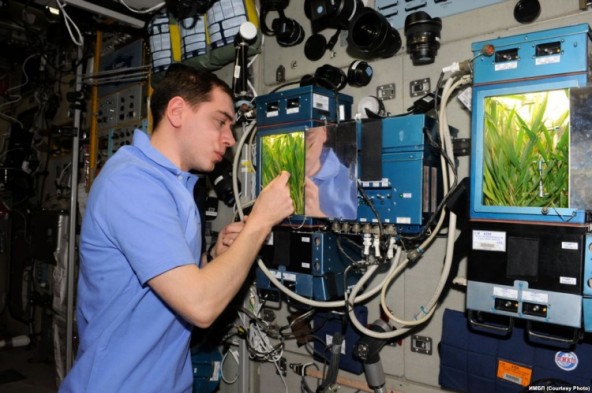
Cosmonaut Sergei Volkov on board the ISS is working with the Lada greenhouse
Having figured out all this and armed with the support of Margarita Alexandrovna, we began to make our own photobioreactor.
The first photobioreactor began to be created during the break in the work on Mayak, when all the tests were completed and it was necessary to wait for the launch. The lull lasted from December 2016 until about the end of April 2017. During this time we have been able to create this.
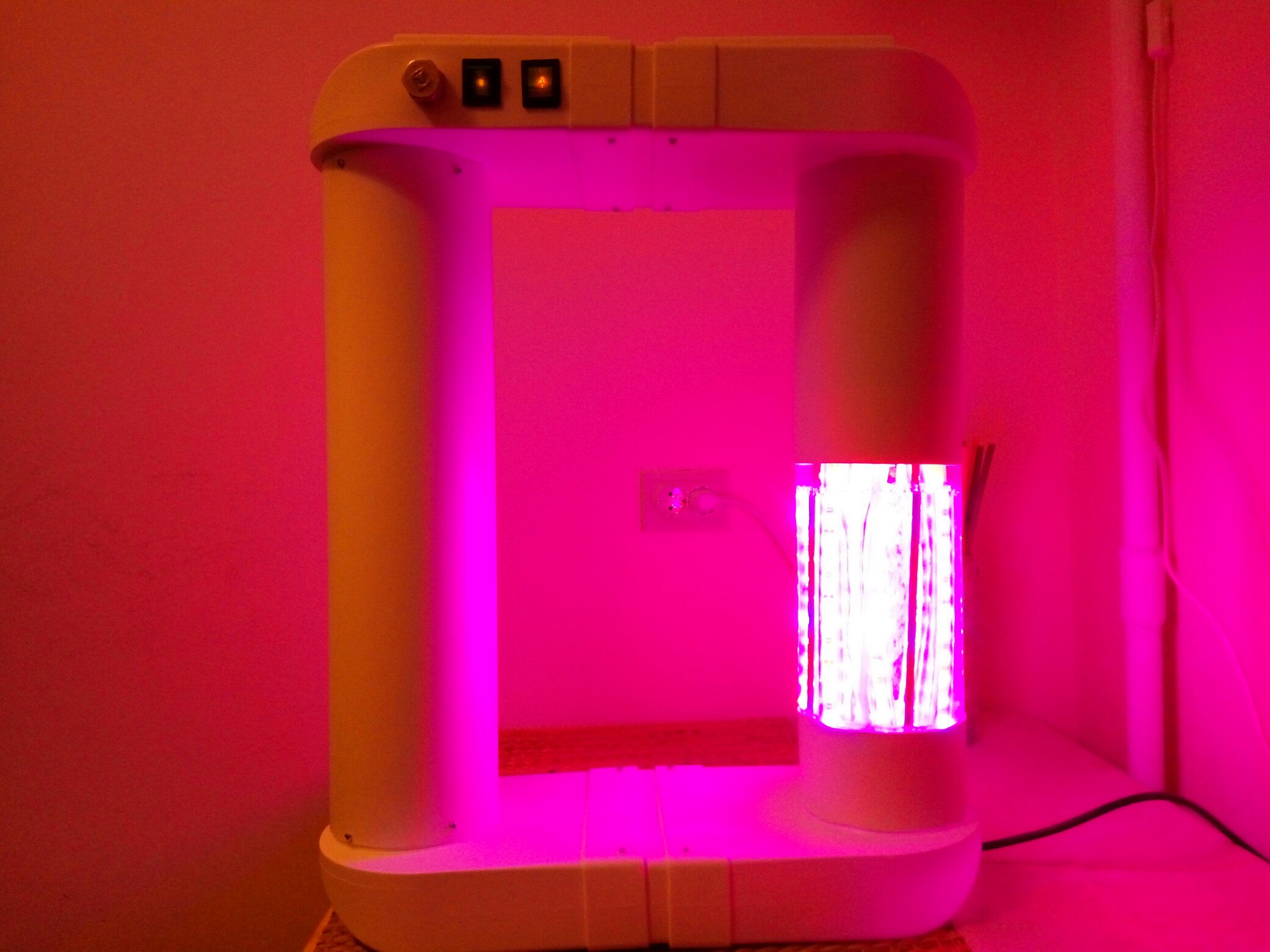
Appearance of the first prototype photobioreactor
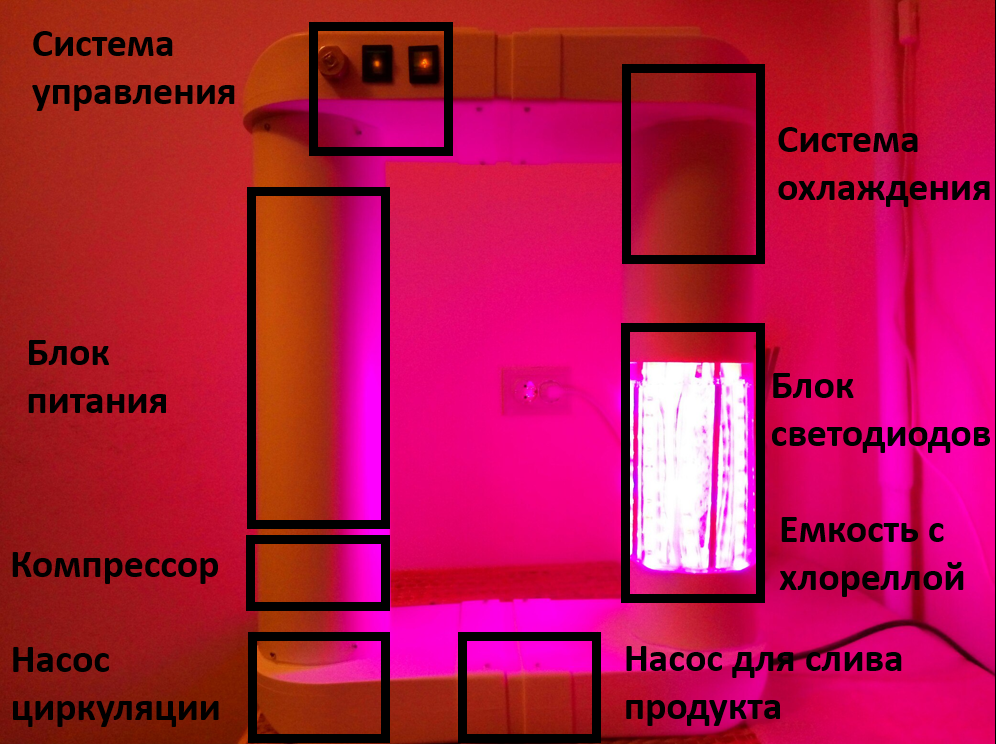
Scheme of the device of the first prototype of photobioreactor
The main characteristics of the first prototype
The volume of medium with chlorella - 2.5 liters.
Mains consumption - 65 watts.
Sources of radiation - LEDs with wavelengths of 440-460 nm, blue, and 650-660 nm, red.
Management - Arduino Mega.
Nutrient medium - Tamiya of the following composition, g / l
Trace elements (g / l):
The composition of the photobioreactor:
In this setup, experiments were conducted according to the following algorithm:
The results of the experiments are shown in the graphs.
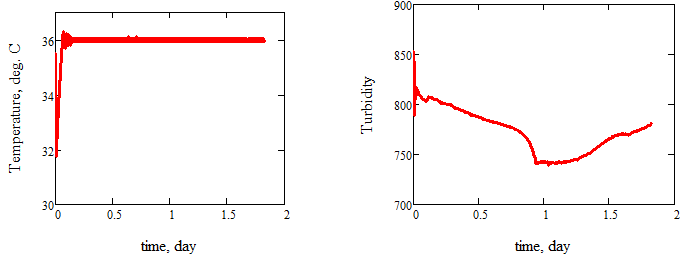
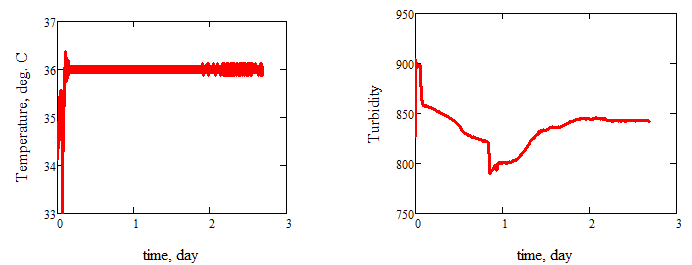
For those interested, raw data are available at the link: goo.gl/eV6wKC
The graphs on the left show that the thermal control system maintains the specified ambient temperature of 36 ° C, optimal for the growth of the culture, during the entire cultivation time, with the exception of the transitional mode at the beginning.
The graphs on the right show that there are four periods in the cultivation process:
The maximum chlorella culture density achieved is 0.1363 mg / l.
The maximum achieved specific productivity of chlorella is 4 * 10 ^ -3 mg / (l * day).
Everything seems to be good, but the indicators of the IMBP reactors are very far away. It turned out:
The maximum chlorella culture density achieved is 20 g / l.
The maximum achieved specific productivity of chlorella is 15 g / (l * day).
If we assume that 900 grams of chlorella contained in 45 liters is enough to support one person’s vital activity, then to place the same amount in our first prototype would require as many as 6603081 liters or 6603 cubic meters! This is more than 33,000 standard baths!
Therefore, after the first prototype, we decided to build a second one in order to obtain high rates, primarily for greater density of the chlorella culture and for specific productivity.
What do we plan to implement in the second prototype?
In more detail about what we plan to do, it is written in the statement of work on the second prototype .
Having implemented these steps, we hope to get closer to the results of IBMP. There is a lot of interesting work ahead, which in the most literal sense will be able to bring flights beyond the limits of low-Earth orbit!
As they say, stay with us, do not change the channel! :)
But today it is not about them. I would like to tell you about the project on creating a biological life support system, which we started after Mayak, and why it was for her.
The idea of "Beacon"
I already wrote that the idea of the Beacon satellite was to show that now in Russia the most ordinary people, like reading this% Username%% article, can create and launch their own spacecraft into space. With the space program you can do it personally, with your own hands, without working in large KBs, not being a millionaire, now in Russia. That you can not only subscribe to the instagram of NASA or Roscosmos or watch popular science lectures, but make your own space projects.
Even while working on Mayak, we thought about what our next project would be and decided that it should contribute to the space program and help it to go beyond the limits of the earth orbit.
')
Well, we want to contribute, but what and where? And here there are many options.
Contribution, what and where
Personally, in my opinion, the last big thing in the manned space program was made in 1969, when the first Apollo expedition set out on the moon. After it, there were five more successful flights, but after them, as early as 1972, not a single person rose above 1000 km above the Earth. None, although it's been 45 years! All cosmonautics, I recall, has only 60 years! And most of this time, people tread on a patch around the Earth!
It seems to me that this is not very cool, and something needs to be done about it. The experience of “Selenohod” and especially “Luna-Glob” aka “Luna-25” taught that it is better to work on your own.
And what do you actually need in order to fly beyond the limits of low-Earth orbit?
If we talk completely about the distant perspective, not just about flights to the Moon or Mars, for which approximately the existing technological level is enough, we need:
- New, more capacious and light sources of energy, from the more advanced chemical at the first stage, to nuclear, thermonuclear and annihilation at the subsequent ones.
- New engines and methods of movement, as when entering into space from celestial bodies, and to move in a vacuum. New energy sources will be used to power jet engines, electromagnetic accelerators and sources of directional radiation to create thrust in solar, laser, magnetic and other types of sails.
- New types of materials capable of working in the harsh conditions of space, suitable for efficient processing into products that will be possible to produce from local raw materials.
- Highly efficient life support systems, first of all, closed biological ones, due to which a full-fledged, unlimited human life in space conditions will be possible.
- Improvement of modern design and production technologies so that the development of newly created complex projects was carried out by a small team in a short time, and the practical implementation of projects was carried out using highly automated, possibly self-developing production facilities at the expense of local resources. This will allow the implementation of the solar system development programs not at the expense of a small number of cumbersome enterprises located on Earth and relying only on land resources, but at the expense of small, quickly responding to changes in highly motivated teams using local raw materials for their work.
Most of this list looks very heavy for a team of 10 people working in their free time. Most of the list, but not all :)
I considered that biological life support systems (LSS) are the direction that can be started to develop without super-laboratories and multi-billion investments. They need plants, greenhouses, something simpler than accelerators for studying antimatter :) In addition, I heard that in Russia they were engaged in this issue and achieved some success, in particular, they built both purely technical systems and systems based on chlorella microalgae and higher plants . I talked about BSZHO with Oleg Voloshin, the press secretary of the Institute of Biomedical Problems (IBMP) of the Russian Academy of Sciences, and he introduced me to Margarita Alexandrovna Levinskikh, who is working in this area.
Before telling about the work in the field of FFSW, it is necessary to explain why life support systems are needed at all and how they developed.
Formal definition of the concept of “life support system”
It should be noted that the history of life support systems development is magnificently described in the actor speech “Life support systems of habitable space objects (Past, Present and Future)” by Dr. Yu.E., Doctor of Technical Sciences, Professor, Honored Scientist of the Russian Federation. Bruise
First we need to give a formal definition of a life support system. To do this, we have GOST 28040-89 "Life support system for an astronaut in a manned spacecraft." According to him, the LSS of the cosmonaut is a combination of functionally interrelated means and activities designed to create conditions in the habitable compartment of a manned spacecraft that maintain the energy exchange of the cosmonaut's body with the environment at the level necessary to maintain its health and efficiency.

Usually it includes:
SOGS - gas supply system,
NWO - water supply system,
SSGO - system of sanitary and hygienic maintenance,
SOP - power supply system,
SOTR - system for ensuring thermal conditions.
Now you can talk about how life support systems have evolved.
LSS in the pre-space era

The first LSS appeared before human space flight and were intended to provide crews with work on stratostatos, high-altitude aircraft, as well as to ensure the vital activity of animals, mainly dogs.
Maintaining the normal composition of the atmosphere was ensured by introducing into its composition oxygen from gaseous or liquefied reserves and the removal of carbon dioxide using chemical reactions of the form:
Ca(OH)2+CO2→Ca(CO3)+H2O
The systems for space were created on the basis of the LSS.
The first space LSS

The first space communications system was first used to support the flight of a Laika dog on the Sputnik-2 spacecraft.
Maintaining the normal composition of the atmosphere was provided by the organization of chemical reactions according to the following scheme:
4KO2+22→32+4KOH
2KON+CO2→K2CO3+H2O
K2CO3+H2O+CO2→2KNSO3
In addition, prototyping devices and a cesspool device were tested in this flight.
On spaceships like Vostok, Voskhod and Soyuz, a chemical reaction scheme was used, similar to that on Sputnik 2, but activated carbon was additionally used for air purification, and on Soyuz ships lithium hydroxide. In addition, on board were cylinders with oxygen and air. The atmosphere was controlled by the content of oxygen and carbon dioxide. The water, preserved by the preparation of silver, was stored on board in metal vessels with an internal volume covered with two-layer polyethylene. In addition, there was a cesspool device and a thermal control system on board.

Partially closed LSS
The reason for the appearance of partially closed LSS is the need to deliver a large amount of oxygen, water, food from the Earth during long space flights with the first LSS. An illustration to the increase in the duration of flights is a table with some typical examples, below is a mass summary of the spent- life components of the life-support system during a flight to Mars with a duration of 500 days according to the performance speech of Yu.E. Bruise


Here it must be said that the estimates for the mass of water for a flight to Mars are surprising when compared with the mass of water consumed now on the ISS, but the big difference is due to the fact that the ISS does not use water for showering, washing, washing clothes and washing dishes, reduces the weight to quite comfortable for modern space technology 9300 kg for 6 people for 500 days.
But when designing a LSS for a Martian ship, you may need both a shower and other needs requiring a large amount of water. In this case, closed life support systems will be urgently needed.
On board the Mir station, successfully operated in a manned mode from 1986 to 2000, the following systems were tested:
- SRV-K is a system for the regeneration of water from atmospheric moisture condensate,
- "SRV-U" - the system of water recovery from urine (urine),
- "SPK-U" - a system for receiving and preserving urine (urine),
- Electron is an oxygen generation system based on water electrolysis,
- Air is a carbon dioxide removal system
- "BMP" - block removal of harmful trace impurities, etc.
Closed biological LSS
Despite the significant reduction in cargo traffic to manned space stations, with the appearance of partially closed LSS at present, only partial closure through air and water has been achieved on real space flights. Now it is assumed that the complete closure of the cycle in oxygen, carbon dioxide, water, food and waste can be achieved using biological life support systems with autotrophic units, that is, with organisms that independently synthesize organic substances from inorganic, roughly speaking, plants.
One of the BSZHO was created in IBMP on the basis of highly productive photobioreactors "Lilac", in which the unicellular alga Chlorella was cultivated. The description of “Lilacs” and other similar Soviet installations can be found in the fundamental work of Tsoglina L.N., Pronina N.A. “Biotechnology of microalgae” .
With the help of “Lilac” were achieved the following parameters of the BSZHO for one person:
volume of photobioreactors - 45 liters,
specific productivity of reactors - 15 g / (l day),
Chlorella suspension density - up to 20 g / l,
consumption of electrical energy for the system - 45 kW.
For comparison, the Soviet space station “Mir” produced less than 35 kW with a crew of 3 people, and the now flying International Space Station - about 100 kW with a crew of 6 people. High consumption was caused by powerful xenon lamps DKsTV-6000 with a power of 6 kW each, and there were 6 of them in the installation. Plus cooling, medium circulation and so on. Then it was not possible to significantly reduce power consumption, so the system did not find application in flight.
However, even in such a BSZHO, it was not possible to completely close the food cycle due to the excess human protein content in chlorella.
Ground loop closure experiments in LSS
We list the main experiments with the BSZhO in chronological order. The above list does not claim to be complete, additions are welcome.
1964, BIOS-1
1966, BIOS-2, Department of Biophysics, Institute of Physics, USSR Academy of Sciences, two-tier human-chlorella life support system, water closure is implemented.
1967-1968, "Year in the Earth's starship" , IBMP. Crew 3 people, isolation for 365 days. Only technical devices were used, without biological elements.
1968, BIOS-2, Department of Biophysics, Institute of Physics, Academy of Sciences of the USSR, conducted the first experiments in the three-man-microalgae-higher plants system.
1972-1984, BIOS-3, Department of Biophysics, Institute of Physics, USSR Academy of Sciences. A series of experiments with crews of up to 4 people. The three-tier system "man - microalgae - higher plants."
1989 - to date, BioHome , NASA, partially closed system, with an emphasis on water purification.
1990 - to date, MELiSSA , ESA. Microalgae to supply oxygen to the “crew” of three rats.
1994 - to present CEEF , Institute for Environmental Sciences, Japan. - A series of experiments on the study of closed ecosystems, including experiments with crews of up to 2 people, up to 4 weeks long.
1991-1994, Biosphere 2 , University of Arizona. A series of unsuccessful experiments in an isolated biosphere with an area of 1.5 hectares simulating tropical forest, ocean, desert, savanna and mangrove estuary. The crew of 8 people.
2017 - to present, Yuegong-365 , China Space Agency. The crew of 4 people, isolation for 1 year. The first crew is 165 days, the second is 200 days. For the production of oxygen, higher plants are used, recycling of waste - with the help of meal worms - the larvae of the mealworm Tenebrio molitor.
Introduction to IBMP
Now you can tell what led familiarity with IBMP. It turned out that there is a whole department dealing with closed biological life support systems. M.A. Levinskih and her colleagues are now engaged in higher plants, for example, the famous Lada greenhouse, which worked on the ISS, is their offspring, but microalgae are close and interesting to them. The most important thing in this is that Margarita Alexandrovna is ready to help us!

Cosmonaut Sergei Volkov on board the ISS is working with the Lada greenhouse
Having figured out all this and armed with the support of Margarita Alexandrovna, we began to make our own photobioreactor.
First prototype
The first photobioreactor began to be created during the break in the work on Mayak, when all the tests were completed and it was necessary to wait for the launch. The lull lasted from December 2016 until about the end of April 2017. During this time we have been able to create this.

Appearance of the first prototype photobioreactor

Scheme of the device of the first prototype of photobioreactor
The main characteristics of the first prototype
The volume of medium with chlorella - 2.5 liters.
Mains consumption - 65 watts.
Sources of radiation - LEDs with wavelengths of 440-460 nm, blue, and 650-660 nm, red.
Management - Arduino Mega.
Nutrient medium - Tamiya of the following composition, g / l
KNO3−5.0;
MgSO4×7H2O−2.50;
KH2PO4−1.25;
FeSO4×7H2O−0.003;
EDTA−0.037;
TraceElements−1ml.
Trace elements (g / l):
H3BO3−2.86;
MnCl2×4H2O−1.81;
ZnSO4×4H2O−0,222;
MoO3−176.4mg/10l;
NH4VO3−229.6mg/10l.
The composition of the photobioreactor:
- nutrient tank,
- medium circulation system
- lighting system,
- system for measuring the optical density of the medium
- system for ensuring the temperature of the environment,
- gas supply system
- control system,
- Power Supply,
- case.
In this setup, experiments were conducted according to the following algorithm:
- The tank was filled with nutrient medium
- In the tank was placed the culture of chlorella,
- Turned on the air supply and mixing.
- The thermoregulation system was turned on, maintaining a constant ambient temperature by periodically turning on the fan.
- The optical density measurement system using the turbidity sensor measured the optical density of the medium. The higher the value on the Turbidity scale in the graphs below, the greater the transparency of the medium, and, consequently, the lower the chlorella content. With the growth of culture, there is a decrease in transparency and a decrease in the value of the parameter Turbidity.
- The installation cultivated chlorella for several days.
The results of the experiments are shown in the graphs.


For those interested, raw data are available at the link: goo.gl/eV6wKC
The graphs on the left show that the thermal control system maintains the specified ambient temperature of 36 ° C, optimal for the growth of the culture, during the entire cultivation time, with the exception of the transitional mode at the beginning.
The graphs on the right show that there are four periods in the cultivation process:
- the initial, in which the microalga did not produce an increase in optical density,
- growth area, which shows a clear increase in optical density and biomass,
- the stabilization area where biomass growth stopped and
- the site of the death of the culture, in which the optical density decreased.
The maximum chlorella culture density achieved is 0.1363 mg / l.
The maximum achieved specific productivity of chlorella is 4 * 10 ^ -3 mg / (l * day).
Everything seems to be good, but the indicators of the IMBP reactors are very far away. It turned out:
The maximum chlorella culture density achieved is 20 g / l.
The maximum achieved specific productivity of chlorella is 15 g / (l * day).
If we assume that 900 grams of chlorella contained in 45 liters is enough to support one person’s vital activity, then to place the same amount in our first prototype would require as many as 6603081 liters or 6603 cubic meters! This is more than 33,000 standard baths!
Therefore, after the first prototype, we decided to build a second one in order to obtain high rates, primarily for greater density of the chlorella culture and for specific productivity.
Second prototype
What do we plan to implement in the second prototype?
- To select the radiation spectrum of the diodes more suitable for chlorella in order to increase the productivity of its cultivation from one spent Watt. To this end, we plan to conduct a series of reactor launches with narrow-band radiation sources and select those that give the fastest growth of chlorella.
- Increase the radiation intensity so that the microalgae cells receive more energy and grow faster. We even consider lasers as such a source :)
- Control all parameters of the nutrient medium - temperature, acidity, gas composition at the reactor inlet and outlet.
- To build a system for automatic cleaning of reactor cavities. It is very long to disassemble it to wash :))
In more detail about what we plan to do, it is written in the statement of work on the second prototype .
Having implemented these steps, we hope to get closer to the results of IBMP. There is a lot of interesting work ahead, which in the most literal sense will be able to bring flights beyond the limits of low-Earth orbit!
As they say, stay with us, do not change the channel! :)
Bibliography
The most interesting thing to read is the real scientific work on the BSZHO theme; therefore, you can use the domestic elibrary.ru system to find them. It should be noted that in the list of publications there are not only works on FSRB.
Publications M.A. Levinsky , IBMP,
Publications by Margaret Alexandrov V.N. Sychev ,
Publications of the head of the laboratory for the management of phototrophic biosynthesis
A.A. Tikhomirov from the Krasnoyarsk Institute of Biophysics,
Information on the work of NASA in the field of LSS ,
Information on the European program Melissa .
Publications M.A. Levinsky , IBMP,
Publications by Margaret Alexandrov V.N. Sychev ,
Publications of the head of the laboratory for the management of phototrophic biosynthesis
A.A. Tikhomirov from the Krasnoyarsk Institute of Biophysics,
Information on the work of NASA in the field of LSS ,
Information on the European program Melissa .
Source: https://habr.com/ru/post/374219/
All Articles